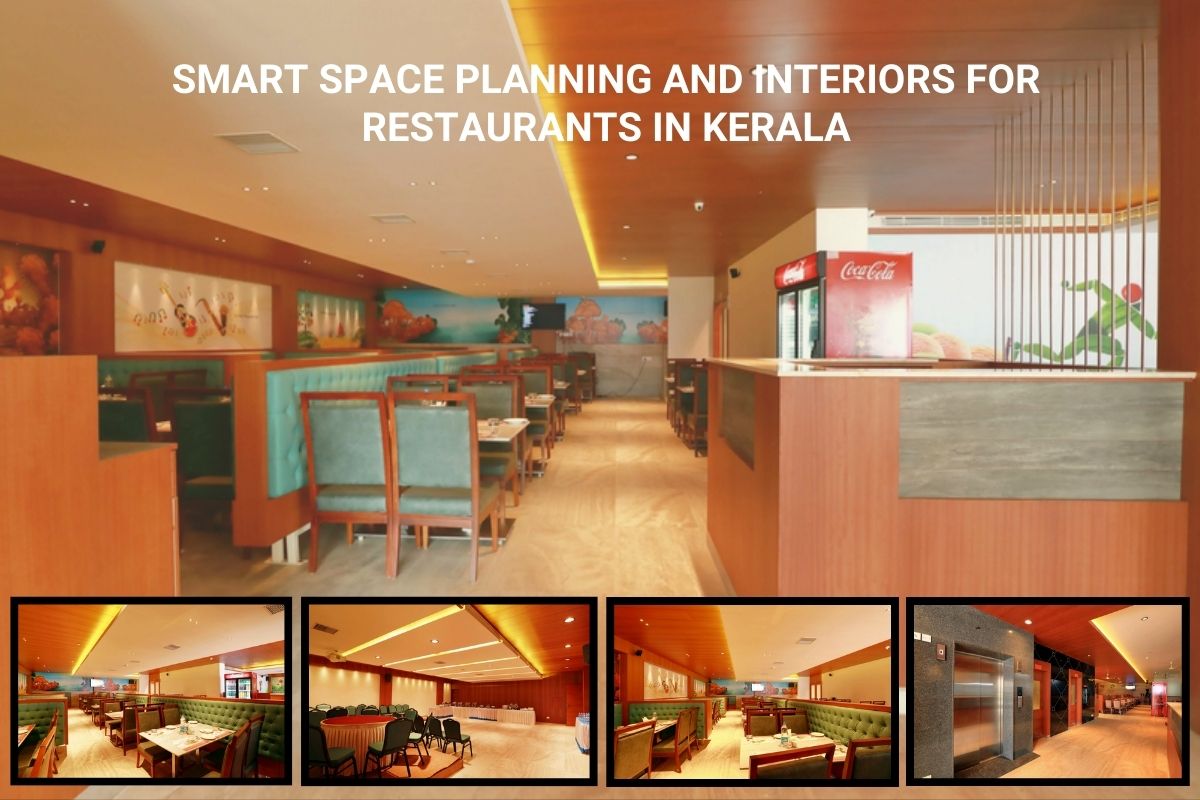


Designing or redesigning a restaurant in Kerala requires a fine balance between maximizing space efficiency, blending with the natural environment, and creating an unforgettable guest experience. Kerala’s diverse terrain—from lush hills to coastal plains—presents unique opportunities and challenges for architects. With expertise in planning restaurant spaces that thrive in this distinctive setting, here we are sharing practical tips to help you make the most of your investment.
Whether you’re building a new restaurant or revamping an existing one, these insights will guide you toward a design that is both functional and visually captivating.
A. Embrace Vertical Design
Space is often at a premium in Kerala’s urban and hilly areas. When we talk of restaurants no one likes cramped small spaces. The space should have nice decor and eventually laid out features.
● Solution: Use verticality to your advantage with mezzanine floors, rooftop dining areas, or multi-level layouts.
● Pro Tip: Incorporate open staircases or glass partitions to maintain a sense of spaciousness even in compact designs.
B. Smart Furniture Choices
With the choice of furniture, specially theme based can do magic to the interiors. Blending the furniture choices with the decor theme can make the entire space look different.
● Modular and stackable furniture allows for flexible seating arrangements.
● Fixed benches along walls save floor space while maximizing seating capacity.
C. Dual-Purpose Features
With the smart construction, spaces can be optimised for better and multipurpose usages.
● Use foldable tables and hidden storage solutions to optimize functionality.
● Combine aesthetics and practicality by designing furniture that doubles as decor, such as benches with planters.
Kerala’s tropical weather is both an asset and a challenge. It is a heaven for the tourists from across the world but gives hardship to the property owners in maintenance. Using designs that suit Kerala weather can reduce the challenges for the restaurant owners.
A. Climate-Responsive Roofing
● Use sloped or terraced roofs to handle heavy monsoon rains.
● Overhangs and pergolas provide shade and protect outdoor seating.
B. Ventilation and Natural Cooling
● Ensure cross-ventilation by aligning windows and openings strategically.
● Ceiling fans and open layouts can significantly enhance airflow, especially in humid coastal areas.
C. Materials That Endure
● Use locally sourced, weather-resistant materials like laterite stone, bamboo, and treated wood.
● Waterproof paints and anti-corrosion treatments are essential for long-term durability.
The ambiance of a restaurant often determines whether patrons return. Here’s how to make a lasting impression:
A. Lighting Matters
● Use warm, diffused lighting for indoor areas to create a cozy atmosphere.
● Highlight key features like artwork, greenery, or architectural details with accent lighting.
● For outdoor spaces, solar-powered fairy lights or lanterns are eco-friendly and charming.
B. Incorporate Local Aesthetics
● Draw inspiration from Kerala’s rich culture by integrating traditional elements like wooden carvings, tiled roofs, or murals.
● Use earthy tones, natural textures, and greenery to create a harmonious blend with the environment.
C. Indoor-Outdoor Harmony
● Use biophilic design principles, such as incorporating indoor plants, water features, or large windows with scenic views.
● For restaurants in picturesque areas like Wayanad or Munnar, outdoor decks or verandas enhance the dining experience.
Comfort is the foremost thing when thinking about the restaurants and resorts. A place can’t be welcoming if it's not comforting. Keep guest comfort as top priority when designing your restaurant space.
A. Spacious Seating Arrangements
● Avoid overcrowding tables; leave ample space for diners and servers to move comfortably.
● Use curved layouts or semi-partitioned booths for added privacy.
B. Acoustics and Soundproofing
● Incorporate soft furnishings like fabric-upholstered chairs or curtains to minimize noise.
● Use acoustic panels or wooden lattices to absorb sound and maintain a tranquil atmosphere.
C. Accessibility
● Design ramps, wide pathways, and accessible restrooms to cater to all guests.
● Use slip-resistant flooring to ensure safety during Kerala’s rainy season.
Outdoor dining is increasingly popular in Kerala, thanks to its stunning natural vistas. People like sitting in the natural surroundings rather than the cramped AC rooms. Keep open air dining as an option in your design, like lawns, terrace or roof top.
A. Weather-Proofing Outdoor Spaces
● Install retractable awnings or transparent canopies to shield diners from sudden rain.
● Use weather-resistant furniture made of treated wood, metal, or high-quality plastics.
B. Elevate the Experience
● Add features like fire pits, outdoor lighting, or hanging plants to enhance the ambiance.
● Create cozy nooks with comfortable seating and throw pillows for an intimate dining vibe.
A well-designed kitchen is vital for smooth operations. Gone are the times when you need not focus on kitchen design. A proper kitchen design is required for efficient handling of orders and movement of staff.
A. Layout Efficiency
● Use the “work triangle” principle, ensuring seamless movement between prep, cooking, and plating areas.
● Include ample storage and refrigeration facilities to accommodate Kerala’s diverse cuisine.
B. Ventilation
● Install powerful exhaust systems to prevent heat and odors from reaching the dining area.
● Natural ventilation can also be enhanced through strategically placed openings.
Sustainable practices not only benefit the environment but also reduce operational costs.
A. Green Building Practices
● Install solar panels to power lighting and appliances.
● Rainwater harvesting systems can supply water for restrooms and landscaping.
B. Local Sourcing
● Using locally available materials reduces transportation costs and carbon footprints.
● Partner with local artisans for decor elements that celebrate Kerala’s cultural heritage.
Stay ahead by incorporating modern trends that appeal to diners:
A. Technology Integration
● Use digital ordering systems or QR code menus for a seamless experience.
● Smart lighting and HVAC systems can improve energy efficiency.
B. Multi-Functional Spaces
● Design areas that can double as event spaces for workshops, performances, or private celebrations.
Designing or redesigning a restaurant in Kerala’s unique terrain is no small feat. But with the right strategies, challenges like uneven plots, tropical weather, and limited space can be transformed into opportunities for creativity and innovation. As an architect, my focus is on crafting spaces that are functional, visually stunning, and deeply connected to Kerala’s environment and culture.
If you’re ready to bring your restaurant vision to life, let’s collaborate and create a space that leaves a lasting impression on your guests while ensuring operational excellence.